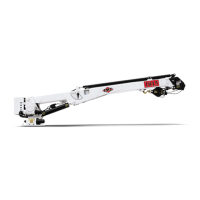99903514:TELESCOPIC CRANE:
2-12 SECTION 2: MAINTENANCE
SLING LOADING
Sling angle (angle of loading) is the angle
measured between a horizontal line and the
sling leg or body. This important angle can have
a dramatic effect on the rated load of the sling.
When this angle decreases, the load on each
leg increases. This principle applies wheter one
sling is used with legs at an angle in a basket
hitch, or for multi-leg bridle slings. Horizontal
sling angles of less than 30° shall not be used.
See Figure B-12.
Figure B-12: Load at Various Sling Angles
Figure B-14: Swivel Hook Grease Zerk
2-6-7: HOOK & LATCH MAINTENANCE
Swivel hooks with grease zerks must be lubri-
cated on a weekly basis. Some hooks have a
grease zerk for this purpose. If the hook on your
crane does not have a grease zerk, you do not
need to lubricate the hook. See Figure B-14.
If a crane latch becomes inoperative due to
wear or deformation, it must be repaired prior to
being returned to service.
20090416
RIGHT LAY
LEFT LAY
2.6-6: WIRE ROPE LAY
Wire rope “lay” indicates the directions strands
lay in the rope - right or left. When you look
down a rope, strands of a right lay rope go
away from you to the right, like a right hand
screw thread. Left lay is the opposite, and
corresponds to a left hand screw thread.
You must choose the correct lay for your winch
drum to avoid winch spooling problems and
rope which does not lay correctly. Use the
following graphics to help in selecting the
correct wire rope based on the direction of drum
winding.
Figure B-13: Wire Rope Lay & Winding
RIGHT LAY
OVERWIND
RIGHT LAY
UNDERWIND
LEFT LAY
OVERWIND
LEFT LAY
UNDERWIND

